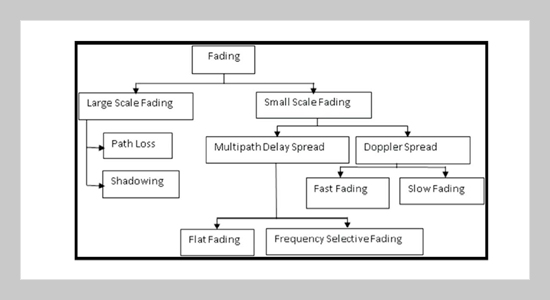REFERENCES
- [1] Hidén Rudander, J., E. Ikram, I. Khuda, P. S. Kildal, and C. Orlenius (2011) Measurements of RFID tag sensitivity in reverberation chamber, IEEE Antennas and Wireless Propagation Letters 10.
- [2] Sachdeva, N., and D. Sharma (2012) Diversity: a fading reduction technique, International Journal of Advanced Research in Computer Science and Software Engineering 2(6), 58_61.
- [3] Xu, L. W., H. Zhang, T. T. Lu, X. Liu, and Z. Q. Wei (2015) Performance analysis of the mobile-relay-based M2M communication over N-Nakagami fading channels, Tamkang University of Science and Technology 18(3), 309_314. doi: 10.6180/jase.2015.18.3.12
- [4] Tanghe, E., W. Joseph, L. Verloock, L. Martens, H. Capoen, K. Van Herwegen, and W. Vantomme (2008) The industrial indoor channel: large-scale and temporal fading at 900, 2400, and 5200 MHz, IEEE Transactions on Wireless Communications 7(7), 2740_2751. doi: 10.1109/TWC.2008.070143
- [5] Rontogiannis, A. A., V. Kekatos, and K. Berberidis (2006) Asquare-root adaptiveV-BLAST algorithm for fast time-varying MIMO channels, 2006 IEEE International Conference on Communications, IEEE 7, 3135_3139. doi: 10.1109/ICC.2006.255287
- [6] Yen, R. Y., H. Y. Liu, and C. H. Yih (2012) Analysis of correlation between ICI and desired carrier power in OFDM systems over frequency-selective ricean fading channels under the influence of Doppler spread, Tamkang University of Science and Technology 15(2), 149_156. doi: 10.6180/jase.2012.15.2.08
- [7] Li, J., A. Bose, and Y. Q. Zhao (2005) Rayleigh flat fading channels’ capacity, 3rd Annual Communication Networks and Services Research Conference (CNSR’05) IEEE, 214_217. doi: 10.1109/CNSR.2005.52
- [8] Luo, X., and X. Zhang (2016) Flexible pilot contamination mitigation with Doppler PSD alignment, IEEE Signal Processing Letters 23(10), 1449_1453. doi: 10.1109/LSP.2016.2601270
- [9] Zhang, X., H. Zhu, and X. Luo (2018) MIDAR: massive MIMO based detection and ranging, 2018 IEEE Global Communications Conference (GLOBECOM) IEEE, 1_6. doi: 10.1109/GLOCOM.2018.8647986
- [10] Cai, J.,W. Song, and Z. Li (2003) Doppler spread estimation for mobile OFDM systems in Rayleigh fading channels, IEEE Transactions on Consumer Electronics 49(4), 973_977. doi: 10.1109/TCE.2003.1261183
- [11] Chavan,M. S., and S. R. Sawant (2011) Multipath fading channel modeling and performance comparison of wireless channelmodels, International Journal of Electronics and Communication Engineering 4(2), 189_203.
- [12] Luo, Z., and F. Hu (2010) Simulation models for independent Rayleigh fading channels, 2010 Global Mobile Congress IEEE, 1_5. doi: 10.1109/GMC.2010.5634573
- [13] Zheng, Y. R., and C. Xiao (2002) Improved models for the generation of multiple uncorrelated Rayleigh fading waveforms, IEEE Communications Letters 6(6), 256_258. doi: 10.1109/LCOMM.2002.1010873
- [14] Yao, X.W.,W. L.Wang, and S. H. Yang (2012) Video streaming transmission: performance modelling over wireless local area networks under saturation condition, IET Communications 6(1), 13_21. doi: 10.1049/iet-com.2010.1013
- [15] Mahajan, M., and D. B. Bhoyar (2011) Performance analysis of CDMAunder Rayleigh Rician and Nakagami fading channels, Thinkquest~2010, 316_319. Springer, New Delhi. doi: 10.1007/978-81-8489-989-4_60
- [16] Khuda, I. E. (2017) Modeling and simulation of UWB wave propagation for early detection of breast tumors in cancer dielectric imaging systems, Engineering Journal 21(2), 237_251. doi: 10.4186/ej.2017.21.2.237
- [17] Ziókowski, C., and J. M. Kelner (2016) Influence of receiver/transmitter motion direction on the correlational and spectral signal properties, 2016 10th European Conference on Antennas and Propagation (EuCAP) IEEE, 1_4. doi: 10.1109/EuCAP.2016.7481225
- [18] Sklar, B. (1997) Rayleigh fading channels in mobile digital communication systems. I. Characterization, IEEE Communications Magazine 35(7), 90_100. doi:10.1109/35.601747
- [19] Iqbal, R., T. D. Abhayapala, and T. A. Lamahewa (2009) Generalised clarke model for mobile-radio reception, IET Communications 3(4), 644_654. doi: 10.1049/iet-com.2008.0054
- [20] Brillinger, D. R. (2012) Fourier Analysis of Stationary Processes, Selected Works of David Brillinger, 195_210, Springer, New York, NY. doi: 10.1007/978-1-4614-1344-8_13
















